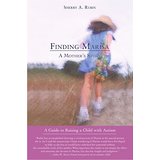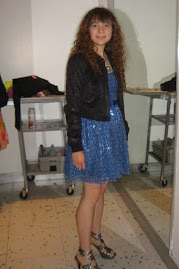"Susan is absent," Marisa answered.
I understood from numerous conversations with Marisa, that Susan was a student on the bus who attended a special school for children with physical disabilities. Because of the need for a wheelchair, extra time was needed for picking up the student in the morning and dropping her off at home in the afternoon.
"Did you ever talk to her?" I asked Marisa.
"No, I listen to my ipod," she responded.
I didn't think too much about this until one day when we went to our village Town Hall to vote. As Marisa came out of the voting booth, she had a noticeable look of delight and surprise to see a familiar face. She ran up to a woman waiting in line to vote, and gave her a warm greeting and a hug, asking her how Susan is. After explaining to Marisa that her daughter had major surgery, she turned to her husband and remarked,
"I can't believe she remembers me!"
I approached the woman and introduced myself as Marisa's mom.
"How does Marisa know you?" I asked.
She informed me that her daughter was on Marisa's bus but was out for a few months because she required major surgery on her knee. After a brief conversation to inquire about Susan's progress, we left Town Hall.
I said to Marisa, "What nice parents Susan has! How come you never spoke to Susan on the bus?"
Marisa's answer surprised me. "She uses a wheelchair."
"Well that isn't a reason not to talk to someone," I said. "She has a physical disability. There are all kinds of disabilities. You have a disability too. How would you feel if someone decided not to speak to you because you have autism?"
Marisa surprised me when she replied, "I like people with autism."
"Well that's very nice, but it doesn't make it okay to ignore others just because their disability is different from yours. Because you have a disability, I think you might try to be more accepting of others with disabilities. Try to be understanding of someone else with a disability. By doing so, more people will perhaps be more accepting and understanding of you too!"
A week later, my dad was rushed to the emergency room. After numerous days in the hospital he made it home in time for Father's Day. We went to see him at home that day. He clearly was not himself and was unable to walk around without a great deal of assistance. Marisa remained quiet but apparently observant.
The next day, my dad called to speak to me, but Marisa answered the phone with her usual greeting, "Hi grandpa, how are you?" Usually at this point she would shove the phone at me and run to her goal chart to record her points for answering the phone with a standard greeting. Instead, she said to him, "Are you feeling better today?" She then waited for an answer.
I stopped what I was doing and realized then that Marisa had gone the extra mile. She was showing acceptance, understanding and compassion for her grandpa, who she had seen and realized was clearly unable to move around by himself. She had stepped outside her self-centered world and shown concern for an other's well being. What more can a mother of a child with autism ask for?








